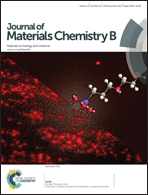Effect of direct loading of phytoestrogens into the calcium phosphate scaffold on osteoporotic bone tissue regeneration†
Abstract
3D porous calcium deficient hydroxyapatite (CDHA) scaffolds with phytoestrogens were fabricated for osteoporotic bone tissue regeneration through a combination of 3D printing techniques and cement chemistry as a room temperature process. Quercetin, one of the major phytoestrogens isolated from onions and apples, was directly incorporated into CDHA for local administration in place of bisphosphonates (BPs) (which are recognized as standard treatment in osteoporosis), to avoid drug side effects. The CDHA scaffolds with quercetin (QC–CDHA) showed favorable mechanical properties (compressive strength < 21 MPa) as well as pore morphology. Quercetin was steadily released with the biodegradation of CDHA scaffolds in vitro without any initial burst. The QC–CDHA scaffolds greatly influenced both osteoblast and osteoclast cell activities. The QC–CDHA scaffolds significantly increased pre-osteoblast cell (MC3T3-E1) proliferation, differentiation, and mineralization, whereas osteoclast cell (RANK treated RAW 264.7) proliferation and differentiation were dramatically suppressed. The influence of quercetin on bone tissue regeneration was superior to alendronate, which is one of the most commonly administered BPs. All results indicated that quercetin in CDHA scaffolds plays an important role in both enhancing bone formation and suppressing bone resorption. Consequently, this technology promises great potential in osteoporotic bone tissue regeneration.


 Please wait while we load your content...
Please wait while we load your content...